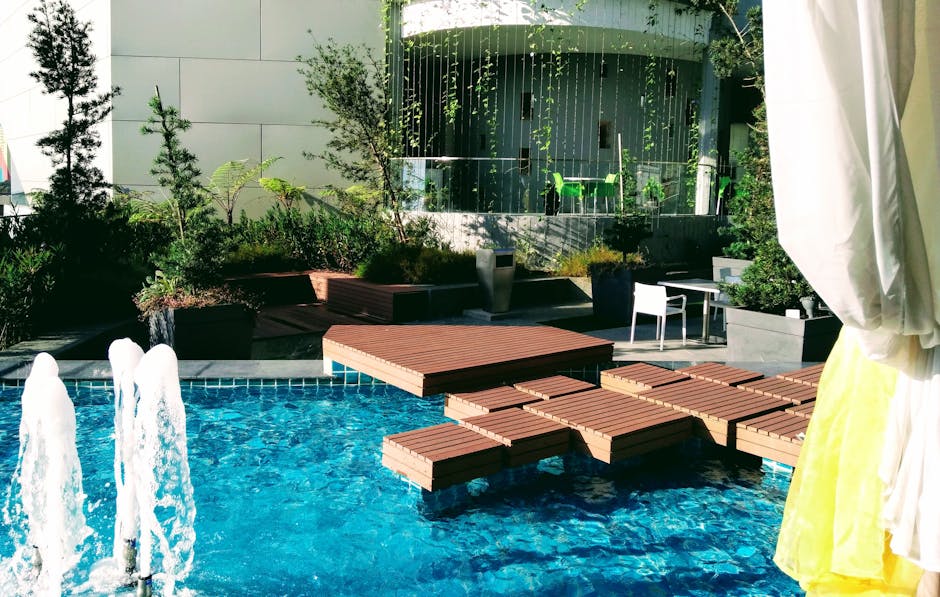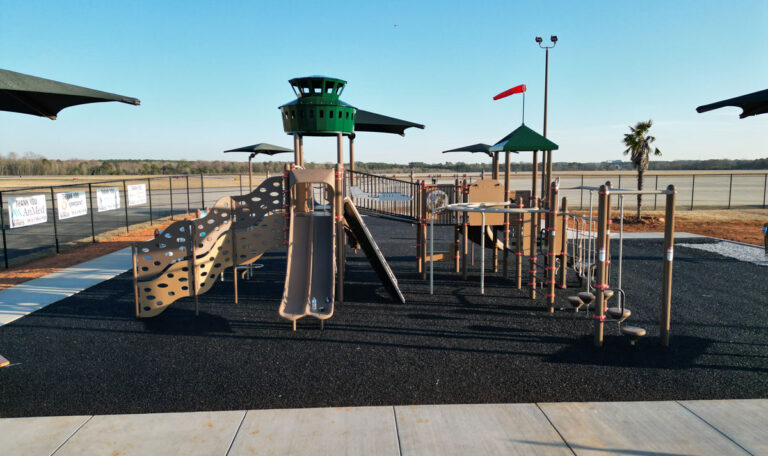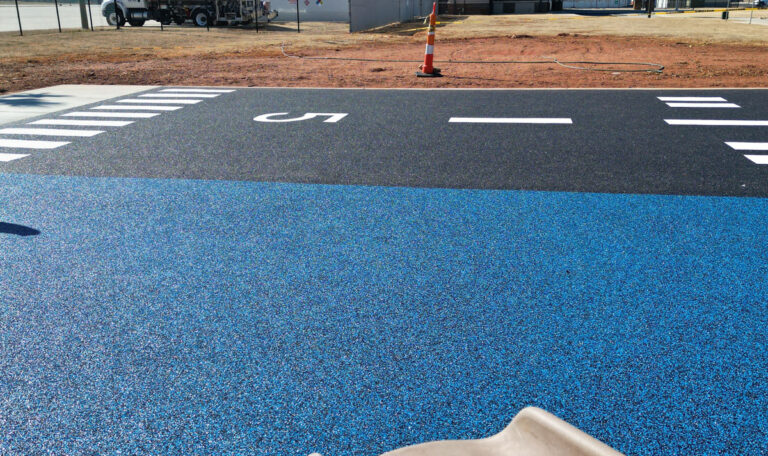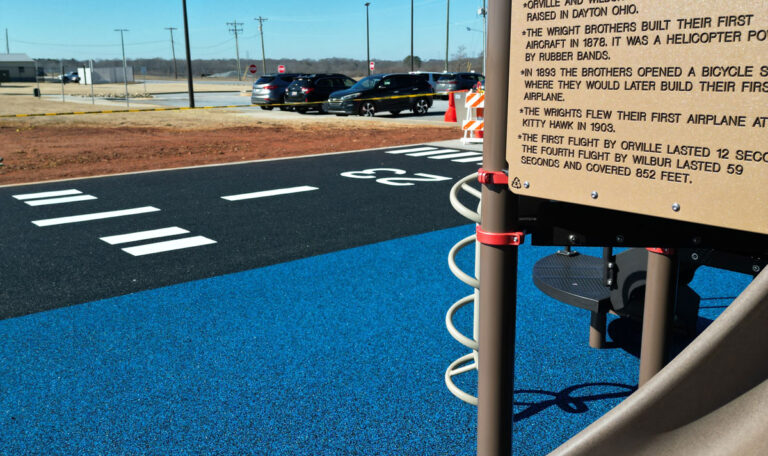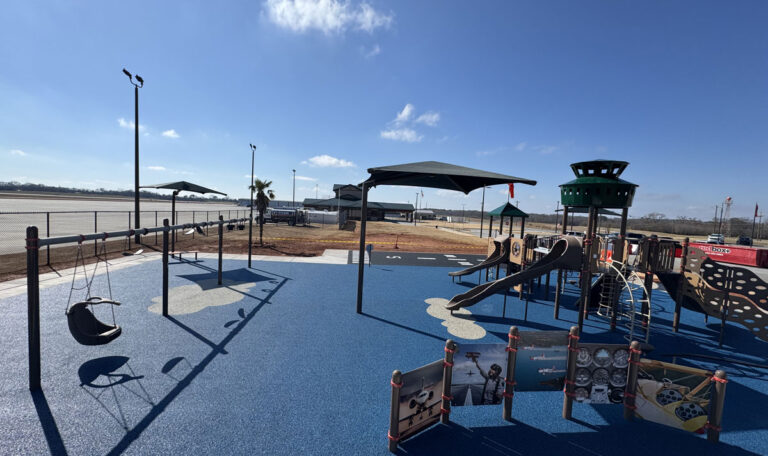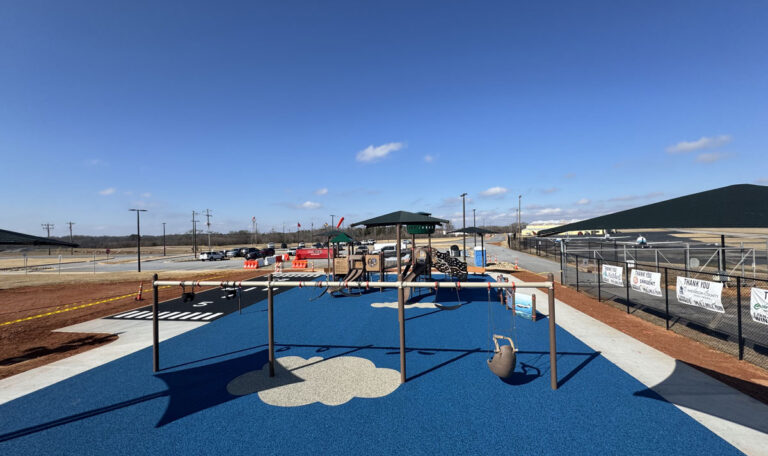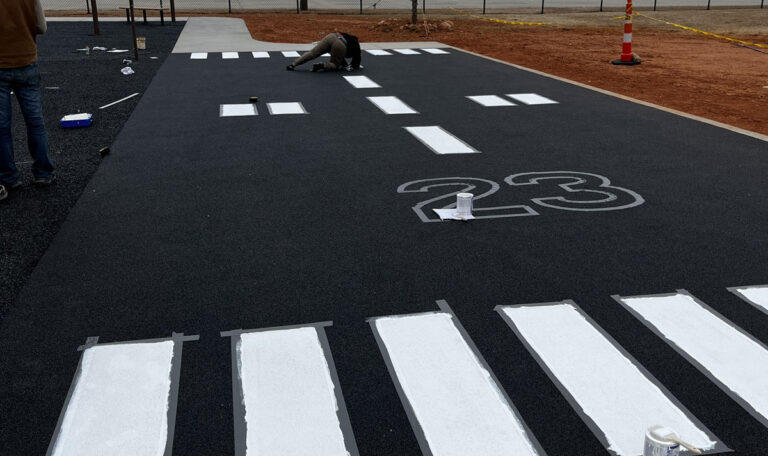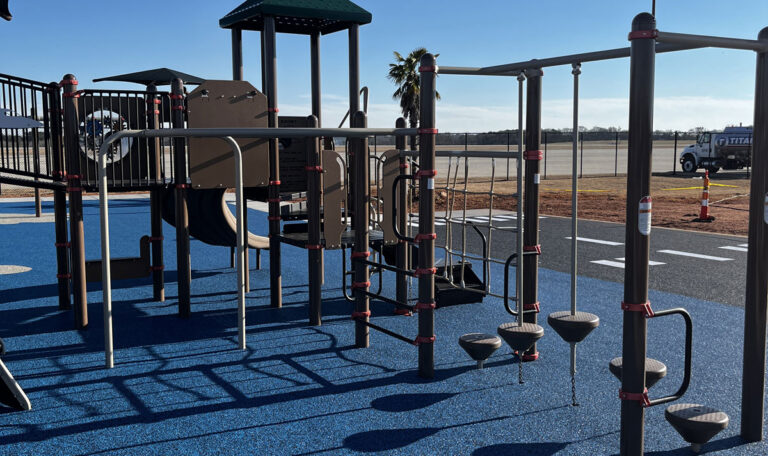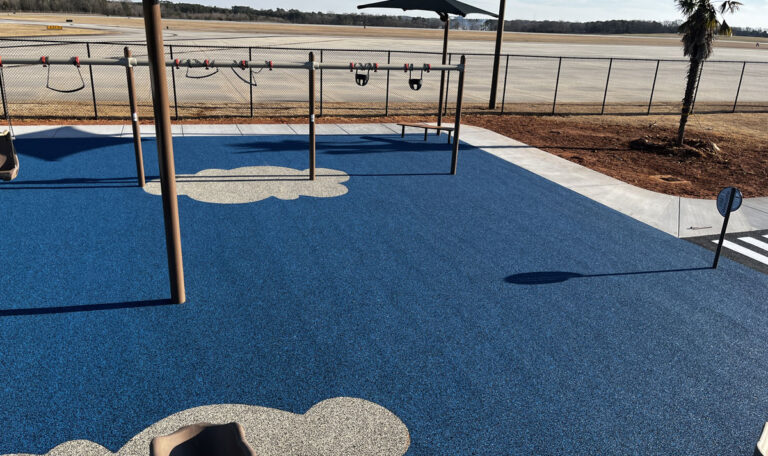Understanding Rubber Pool Deck Pricing: The Complete Financial Picture
Rubber pool deck cost typically ranges from $8 to $14 per square foot for professional installation, making it a premium choice compared to traditional concrete decking. Here’s what you need to know about the investment:
Quick Cost Breakdown:
- Small decks (300-600 sq ft): $5,500 – $10,000
- Medium decks (700-1000 sq ft): $10,000 – $16,000
- Large decks (1100-1500 sq ft): $17,000 – $25,000
- DIY materials only: ~$10 per square foot
Pool deck surfaces are more than just functional – they’re a space for lounging, entertaining, and making memories. But when concrete gets scorching hot in summer or becomes dangerously slippery when wet, it’s time to consider alternatives.
Rubber pool decking transforms recycled tires into a slip-resistant, shock-absorbing surface that stays cool underfoot and lasts 12-15 years with minimal maintenance. While the upfront investment is higher than concrete, the long-term value comes from reduced injuries, lower maintenance costs, and improved comfort.
The challenge? Understanding exactly what drives these costs and whether the investment makes sense for your specific situation. Factors like deck size, site preparation, design complexity, and regional labor rates all impact your final price.
I’m Landon Olson, founder of Replay Surfacing Inc., where we’ve helped hundreds of facility managers and homeowners steer rubber pool deck cost decisions over the past decade. My mechanical engineering background and MBA help me break down complex pricing structures into actionable insights that drive smart investment decisions.
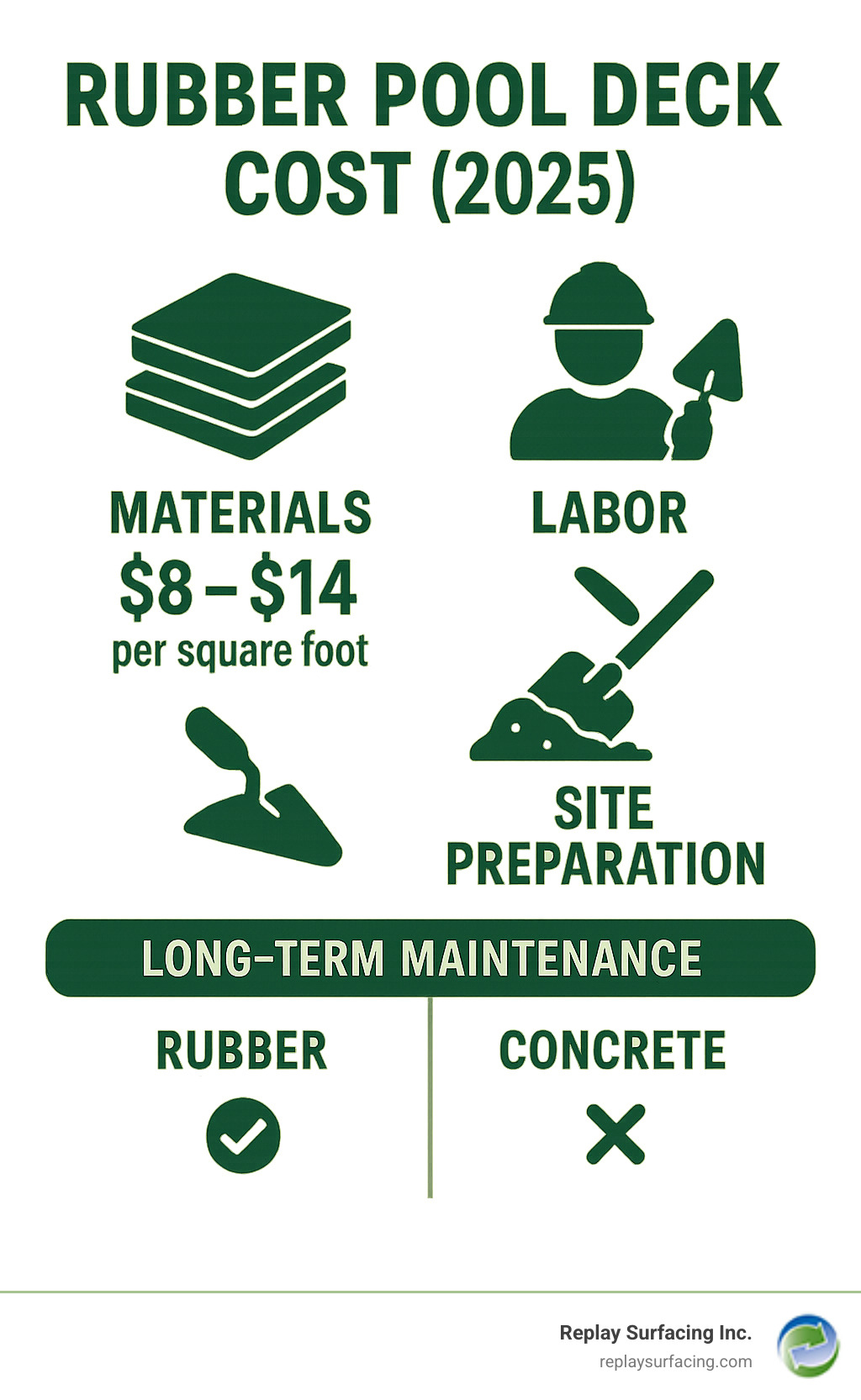
Simple rubber pool deck cost word guide:
Why Cost Matters Before You Cannonball
Budget planning for pool deck resurfacing isn’t just about the sticker price – it’s about understanding the total investment and long-term return. When we work with clients across our locations from Charlotte, NC to Tucson, AZ, we see the same pattern: homeowners who focus solely on upfront costs often end up spending more over time.
The peace of mind that comes from knowing your pool deck won’t crack, won’t burn bare feet, and won’t send someone to the emergency room with a slip-and-fall injury? That’s priceless. But the financial benefits are measurable too. Our clients typically see reduced maintenance costs, fewer repair calls, and increased property values that justify the initial investment within 3-5 years.
Understanding Rubber Pool Decking: Material, Benefits & Drawbacks
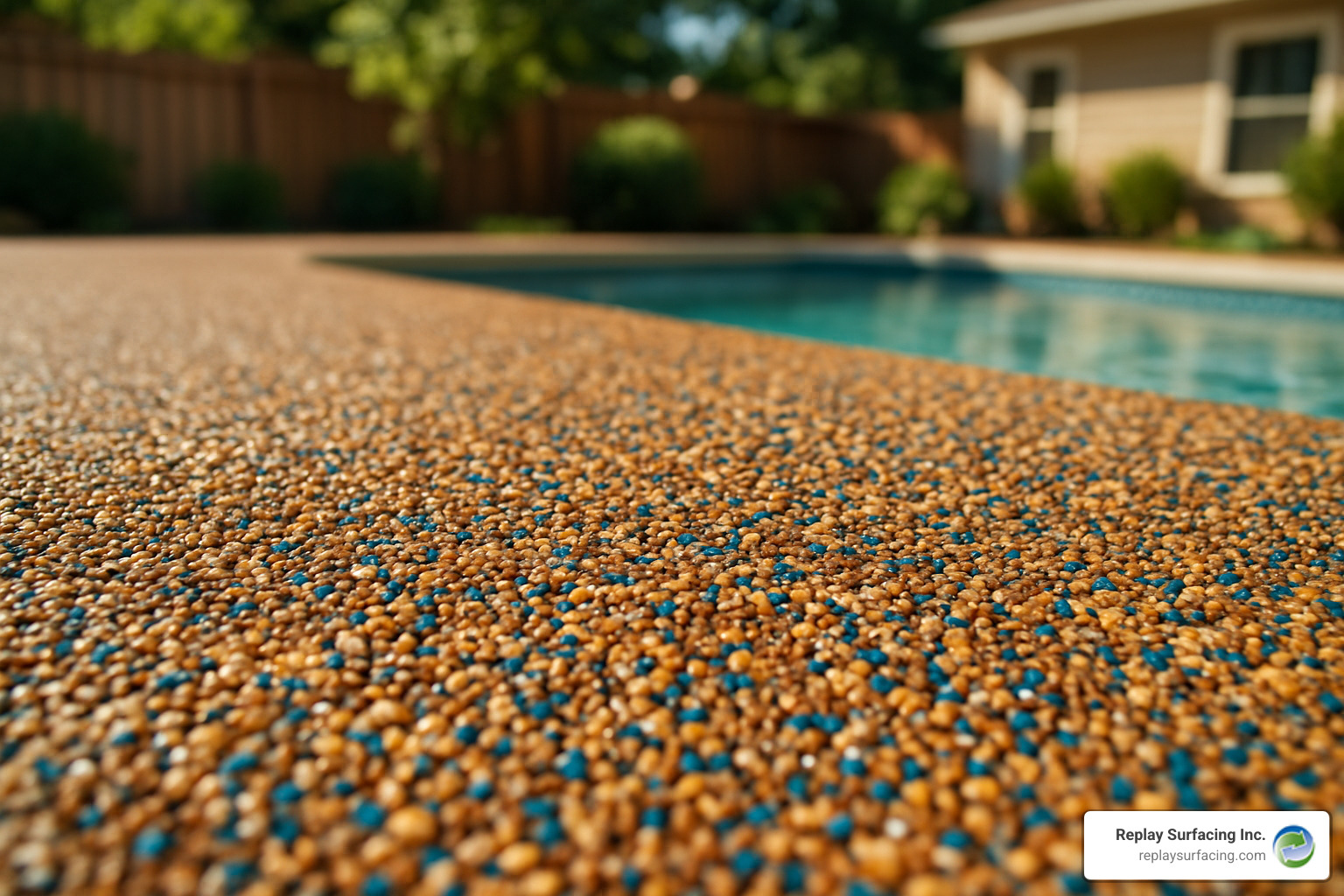
Think of rubber pool decking as giving old tires a glamorous second life. We combine recycled tire crumb with specialized binders and top it with EPDM granules for vibrant colors. The base layer uses 100% recycled tire material, while the top wear layer gets those colorful EPDM granules for lasting beauty.
The porous surface drains up to 75 gallons per minute per square yard. No more puddles, no more slip hazards. The heat reduction is a game-changer – while concrete turns into a griddle, rubber surfaces stay 30-40 degrees cooler. The shock absorption comes from rubber’s natural bounce-back ability, providing cushioning that reduces injury risk.
What Makes Rubber Decking Unique?
The flexibility of rubber surfacing is like having a deck that does yoga – it bends without breaking. While concrete cracks under pressure, rubber surfaces roll with the punches. Temperature swings that would make concrete crack? Rubber just shrugs them off. This natural give means no expansion joints, no ugly saw cuts, and no cracking.
The seamless layer application creates one continuous surface that flows around curves, wraps pool edges, and adapts to any shape your imagination can dream up.
Key Benefits for Pool Owners
Walking on rubber decking feels like the difference between concrete sidewalks and a yoga mat. The soft underfoot sensation makes lounging comfortable instead of feeling like you’re camping on rocks.
The non-slip properties work even when everything’s soaking wet. While concrete becomes an ice rink when wet, rubber maintains its grip. We’ve had clients go from multiple slip incidents per year to zero after installation.
Easy cleaning means spending less time scrubbing and more time swimming. A quick hose-down handles most messes, while stubborn stains surrender to mild soap and water. The anti-bacterial and anti-fungal properties keep things fresh.
Chemical resistance is crucial when dealing with pool chemicals daily. Chlorine, salt water, and other pool treatments that can etch concrete just bounce right off rubber surfaces.
Potential Limitations to Consider
The higher upfront cost – rubber decking isn’t the bargain-basement option. At $8-$14 per square foot installed, it costs more than basic concrete resurfacing. But when you factor in longevity and reduced maintenance, that rubber pool deck cost gap narrows considerably over time.
Color fade risk is real, especially with darker colors in sun-baked climates. While EPDM granules fight UV rays better than most materials, some fading happens over 12-15 years. Lighter colors age more gracefully.
Professional installation is strongly advised – the specialized tools, techniques, and experience required make DIY installation risky for most homeowners. A poorly installed surface can fail early, turning cost savings into costly repairs.
Rubber Pool Deck Cost in 2025: What to Budget Per Square Foot

When homeowners ask about rubber pool deck cost, the honest answer is that it depends on your specific situation. The $8-$14 per square foot range reflects the reality that no two pool decks are identical. Your final investment depends on everything from your existing deck’s condition to design complexity.
Material costs typically account for about 40-50% of your total investment, while labor, site preparation, and project management make up the rest. Regional differences play a bigger role than most people expect. Urban markets often see labor rates 15-20% higher than smaller communities.
The warranty protection you get with professional installation adds real value. Most reputable installers offer 5-10 year warranties on both materials and workmanship.
Core Factors Driving Rubber Pool Deck Cost
The biggest surprise? Preparation work often costs more than the rubber itself. A pool deck in decent shape might need minimal prep work. But if your concrete looks like a roadmap of cracks or has settling issues, you’re looking at extensive preparation that can double your base cost.
Square footage affects your per-square-foot pricing more than you might think. Larger projects spread fixed costs over more area. Projects under 300 square feet often carry premium pricing, while larger decks get better rates.
Thickness requirements depend on your deck’s condition and intended use. Most pool decks work perfectly with our standard 1/2-inch system, but heavily damaged surfaces might need up to 1 inch of material.
Custom designs and colors typically add $1-3 per square foot to your base cost. Standard colors don’t affect pricing, but custom color matching or detailed artwork requires additional materials and labor time.
Site access makes a huge difference in labor efficiency. Pool decks we can reach with our equipment install faster and cost less. Backyard pools requiring hand-carrying materials through narrow gates increase labor costs significantly.
Rubber Pool Deck Cost vs Other Surfaces (Concrete, Pavers, Tile)
| Surface Type | Cost per Sq Ft | Lifespan | Maintenance | Slip Resistance |
|---|---|---|---|---|
| Rubber | $8-$14 | 12-15 years | Minimal | Excellent |
| Concrete | $3-$7 | 10-20 years | Moderate | Poor when wet |
| Pavers | $10-$20 | 10-15 years | High | Good |
| Tile | $15-$25 | 15-25 years | Moderate | Variable |
The lifecycle savings of rubber surfacing become clear when you factor in maintenance requirements over time. Concrete decks need regular sealing, crack repairs, and eventual complete resurfacing. Pavers require constant joint maintenance, releveling, and individual replacements.
Our rubber surfaces? An annual hose-down and occasional rebinder application every few years. That’s it.
For more information about Safe non-slip surfaces, the safety benefits alone can justify the cost difference. One prevented slip-and-fall injury saves thousands in medical bills.
Price Bands: Small, Medium & Large Deck Examples
Small Decks (300-600 sq ft): $5,500-$10,000
These projects typically surround above-ground pools or provide basic access areas. The higher per-square-foot cost reflects fixed mobilization costs spread over fewer square feet.
Medium Decks (700-1000 sq ft): $10,000-$16,000
This size range covers most residential pool decks with adequate space for furniture and entertaining. The per-square-foot cost drops as economies of scale take effect.
Large Decks (1100-1500 sq ft): $17,000-$25,000
Large residential or small commercial installations benefit from our best per-square-foot pricing. These substantial projects often include complex designs and multiple colors.
DIY Materials: ~$10 per square foot
For experienced DIY enthusiasts, material-only costs average $10 per square foot. This includes rubber granules, binder, primer, and basic application tools. However, specialized equipment adds to your initial investment.
More details about Rubber Pool Decking Surfaces can help you understand the complexity involved and make an informed decision about DIY versus professional installation.
Installation, Lifespan & Maintenance Economics
Getting your rubber pool deck installed is surprisingly straightforward. The typical installation spans 1-3 days depending on your deck size and prep work needed. Once everything’s applied, you’ll need 24-48 hours to cure fully before you can safely walk on it.
The 12-15 year lifespan we quote is based on real-world performance from hundreds of installations across different climates and usage patterns. With proper care, we’ve seen well-maintained surfaces push past 15 years looking nearly as good as new.
Your annual maintenance routine couldn’t be easier – just hose down the surface and remove debris. Every couple of years, a rebinder application helps maintain surface integrity and keeps everything looking fresh.
Step-by-Step Installation Overview
Every project starts with inspection and assessment of your existing deck. We look for structural issues, drainage problems, and anything that might cause trouble down the road.
Repairs and preparation come next – any cracks get filled, holes get patched, and the entire surface gets cleaned and degreased. Priming creates the bond between your old deck and the new rubber surface.
Mixing and application is where the change really happens. Rubber granules and binder get mixed on-site in precise ratios, then troweled to the specified thickness. Edging and details require a steady hand – pool copings, drains, and other features get carefully finished.
The curing period tests everyone’s patience, but it’s non-negotiable. The surface needs 24-48 hours of undisturbed time to set properly.
DIY Material Costs vs Professional Labor
The DIY materials cost of roughly $10 per square foot looks tempting, potentially saving about 35% on total project costs. But you’ll need specialized mixing equipment, trowels, measuring devices, and safety gear. These tools can easily add $500-$1,500 to your project cost.
The learning curve is steeper than most homeowners expect. Warranty implications are perhaps the biggest consideration. Professional installations come with comprehensive warranties covering both materials and workmanship. DIY installations typically void manufacturer warranties.
Long-Term Value: Lifespan, Repairs & Recoating
The rebinder application every 2-3 years costs approximately $1-2 per square foot and significantly extends your surface life. Compare that to concrete resealing or paver releveling, and rubber maintenance looks like a bargain.
Repairs are refreshingly minimal over the surface lifetime. Small damaged areas can be patched relatively easily, unlike concrete where one crack often leads to extensive repair work.
When you calculate the total cost of ownership including maintenance, repairs, and eventual replacement, rubber surfacing becomes competitive with other premium surfaces.
For more detailed information about Rubber Pool Deck Resurfacing, understanding these long-term considerations helps ensure you’re making the right investment for your specific situation.
Environmental & Design Perks That Add Value
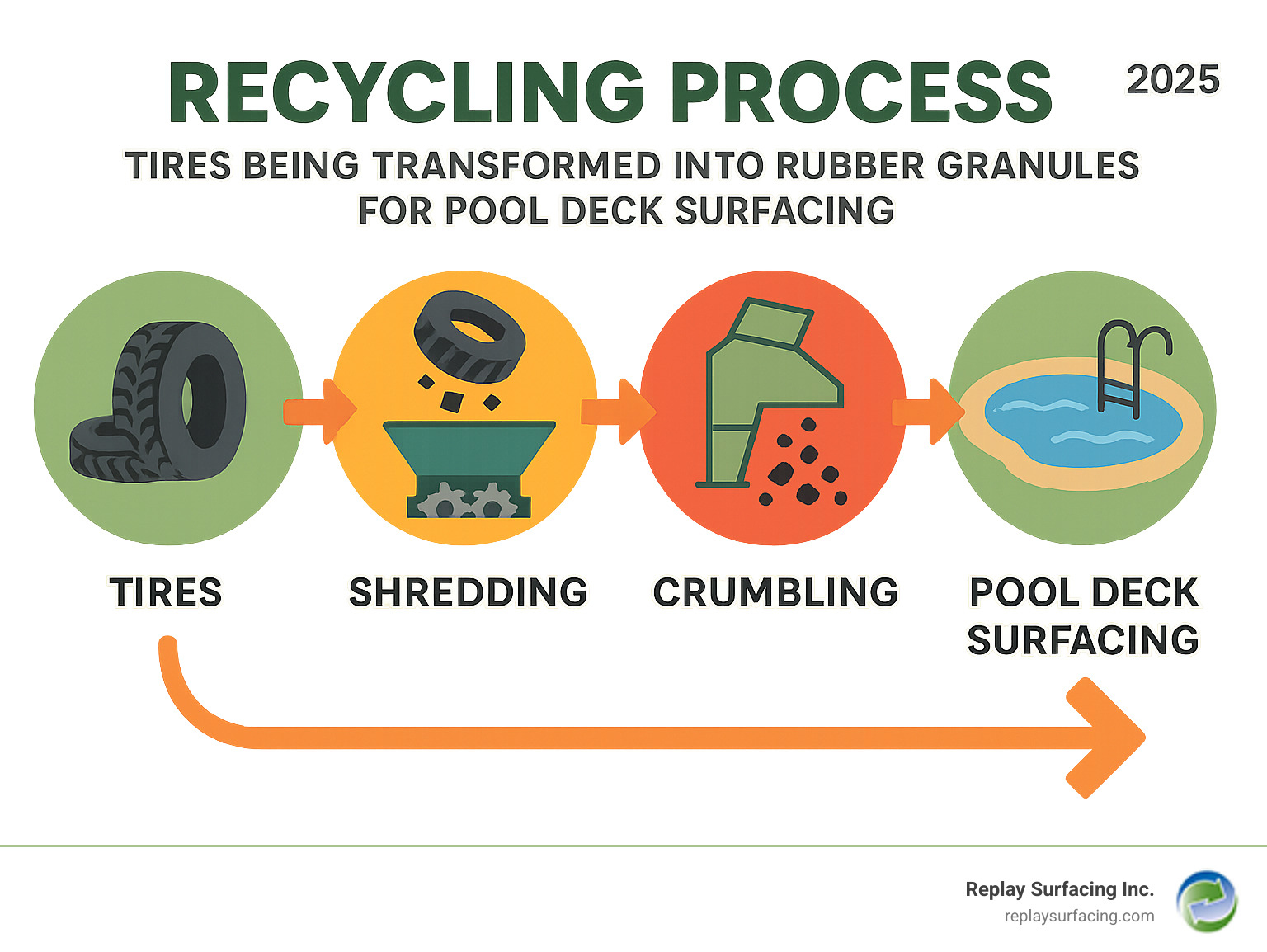
When you choose rubber pool decking, you’re making both a smart financial decision and an environmental statement. Every typical 500 square foot deck rescues 75-100 scrap tires from heading to landfills, where they’d sit for centuries creating environmental headaches.
The environmental benefits go beyond tire recycling. LEED certification projects can earn valuable points by using rubber surfacing. The recycled content, regional materials, and stormwater management capabilities check multiple boxes for green building standards.
Our rubber surfaces allow water to pass through at rates up to 75 gallons per minute per square yard. No more standing puddles, no more contributing to neighborhood flooding. Heat-reflective colors make a real difference in hot climates, keeping surfaces cooler and reducing air conditioning costs.
Sustainability Credentials
The tire recycling story is bigger than most people realize. America tosses about 280 million scrap tires every year, and only about 80% find new uses. By choosing rubber surfacing, you’re supporting an industry that turns environmental problems into solutions.
Stormwater drainage capabilities mean your pool deck becomes part of the solution. Traditional concrete sheds water fast, sending it rushing toward storm drains. Rubber surfaces let water soak through naturally, helping recharge groundwater.
The carbon footprint comparison is eye-opening. Concrete production ranks among the biggest industrial contributors to CO₂ emissions. Meanwhile, rubber surfacing uses post-consumer waste as its main ingredient.
Customization Spectrum & Heat-Mitigation Colors
EPDM granule blends open up a world of color possibilities. Want to match your home’s trim color? Done. Dreaming of a custom logo in your pool deck? We can make it happen.
Cool pigments aren’t just marketing hype – they’re real technology that keeps surfaces 30-40 degrees cooler than traditional dark materials. In places like Tucson, where summer temperatures laugh at the 100°F mark, this isn’t just comfort – it’s necessity.
Pattern planning lets your creativity run wild. We can create neat borders that frame your pool perfectly, incorporate family logos, or design geometric patterns that turn your deck into a work of art.
When you factor in the environmental benefits and design flexibility, the rubber pool deck cost becomes more than just an expense – it’s an investment in sustainability and personalization that concrete simply can’t match. Check out our Custom Color Pool Decks to see what’s possible when recycled tires meet creative vision.
Frequently Asked Questions about Rubber Pool Deck Cost
These are the questions we hear most often when homeowners start exploring rubber pool decking options. After installing hundreds of pool decks across the country, we’ve learned that understanding the real costs and benefits upfront helps families make confident decisions.
How much does rubber pool decking cost per square foot?
Rubber pool deck cost typically runs $8-$14 per square foot when professionally installed. About half of this goes toward materials, while the rest covers labor, site preparation, and overhead costs that ensure your deck lasts the full 12-15 years.
If you’re handy with tools and have experience with similar projects, DIY materials cost around $10 per square foot. But here’s the catch – you’ll need specialized mixing equipment, trowels, and measuring tools that can add $500-$1,500 to your project. Plus, mistakes are expensive to fix, and you’ll void most manufacturer warranties.
The price you pay depends heavily on your specific situation. A small 300-square-foot deck around an above-ground pool will cost more per square foot than a large 1,200-square-foot entertainment area. Why? Because we still need to bring the same equipment and crew regardless of size.
Site preparation can dramatically affect your final cost. A pool deck in good shape with minimal cracks needs basic prep work. But if we’re dealing with significant damage, drainage issues, or major repairs, the preparation work can easily double your investment.
Is rubber pool decking worth the higher upfront price?
This question hits home for us because we see the change firsthand. Last summer, we worked with a family in Nashville whose concrete deck had sent three different family members to urgent care with slip-and-fall injuries. Six months after installation, they told us their pool area had become the neighborhood gathering spot again.
The safety benefits are immediate and measurable. Rubber pool deck cost might seem high upfront, but compare that to a single emergency room visit. The slip-resistant surface maintains traction even when soaking wet, while the shock-absorbing properties reduce injury severity if someone does fall.
The comfort factor changes how you use your pool area. Concrete gets scorching hot in summer – we’ve measured surface temperatures over 150°F on dark concrete in Phoenix. Rubber surfaces stay 30-40 degrees cooler, so bare feet stay comfortable all day long.
From a financial perspective, the numbers work out over time. You’ll spend less on maintenance, avoid costly crack repairs, and won’t need to resurface as often. Many of our clients report that their pool areas get significantly more use after installation, which represents real value for families who invested in a pool for entertainment and relaxation.
How long will a rubber pool deck last before resurfacing?
With proper installation and basic maintenance, you can expect 12-15 years from your rubber pool deck. We’ve seen well-maintained installations in moderate climates exceed 15 years, while surfaces in harsh conditions or with poor maintenance might need attention around the 10-year mark.
The beauty of rubber surfacing is how simple the maintenance really is. Most of our clients spend maybe 30 minutes twice a year hosing down their deck and removing debris. Compare that to concrete decks that need annual sealing, crack monitoring, and regular repairs.
Every 2-3 years, you’ll want to apply a rebinder treatment that costs $1-2 per square foot. This simple maintenance step significantly extends your deck’s life and keeps it looking fresh. It’s like getting your car’s oil changed – a small investment that prevents major problems down the road.
The key is catching small issues early. If you notice any loose areas or minor damage, a quick patch job prevents bigger problems. Unlike concrete where cracks spread and worsen over time, rubber surfaces tend to contain damage to small areas that are easy and inexpensive to fix.
Conclusion & Get Your Custom Quote
Making the right choice about rubber pool deck cost means looking at the whole picture, not just the sticker shock. Yes, that $8-$14 per square foot feels like a big number upfront. But when you’re hosting your next pool party and watching kids run safely on a surface that won’t burn their feet or send them sliding into the water, you’ll know you made the smart choice.
We’ve walked through the numbers together – from small deck investments of $5,500 to larger projects reaching $25,000. The math works because rubber surfacing pays you back through reduced maintenance, fewer injuries, and years of comfortable use. While concrete might seem cheaper initially, those savings disappear quickly when you factor in repairs, resurfacing, and the peace of mind that comes with a truly safe pool deck.
At Replay Surfacing Inc., we’ve helped hundreds of families across our locations from Charlotte, NC to Beaverton, OR transform their pool areas from hazardous hot spots into comfortable gathering spaces. Our mission of changing environmental hazards into sustainable, customizable surfaces isn’t just corporate speak – it’s what we do every day, one recycled tire at a time.
Your specific project cost depends on several key factors we’ve covered. Deck size affects your economies of scale, while site preparation can make or break your budget. Design complexity and regional labor rates add their own variables. The good news? These factors are all predictable once we look at your specific situation.
The cheapest option upfront rarely delivers the best long-term value. We’ve seen too many homeowners regret cutting corners on pool deck surfacing. The emergency room visit from a slip-and-fall accident costs more than the price difference between concrete and rubber.
Ready to see what a custom rubber pool deck would cost for your specific project? Our team provides detailed quotes based on your exact requirements, site conditions, and design preferences. We’ll help you understand not just the upfront investment, but the total value proposition over the 12-15 year lifespan of your new surface.
Contact us today to schedule a consultation and find how we can transform your pool area into a safer, more comfortable, and more sustainable space. We’re not just selling you a surface – we’re helping you invest in years of worry-free pool enjoyment.
For complete details about our services and to see examples of our work, visit Rubber Surfacing for Pool Decks and see how we’re helping property owners across the country make smarter surfacing decisions.
Your future self will thank you for choosing comfort, safety, and sustainability over the cheapest option. The best time to invest in a quality pool deck surface is today.

